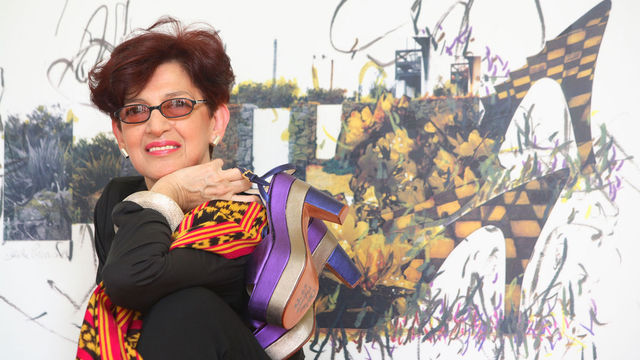
Dalila Puzzovio
Born in 1943, Dalila Puzzovio gained prominence in her native Argentina for fusing pop art, fashion, and conceptual art. Between 1955 and 1962 she studied with the surrealist painter Juan Batlle Planas (1911–1966) and with the conceptual artist Jaime Davidovich (1936–2016). Her first exhibition, held in 1961 at Galería Lirolay in Buenos Aires, consisted of paintings. For her second exhibition, Cáscaras (1963), she showed sculptures made largely of discarded plaster casts and other objects. She referred to these sculptures as "cáscaras astrales" (astral shells) because she felt they retained the aura of the bodies that they once held and were thus a type of medical readymade. Puzzovio was one of more than thirty artists to participate in the 1964 exhibition New Art of Argentina, organized by the Walker Art Center in Minneapolis and the Instituto Torcuato Di Tella in Buenos Aires.
During the 1960s in Argentina several artists created pop art, including Puzzovio, Edgardo Giménez (b. 1942), and Puzzovio's husband, Carlos "Charlie" Squirru (b. 1934), with whom she collaborated on art actions that fused performance with daily life. In 1965, for instance, the trio displayed a billboard at the intersection of two of Buenos Aires's main thoroughfares that read "¿Por qué son tan geniales?" (Why are they so great?), written directly on top of their faces. The message represented an advertisement for themselves and a self-deprecating response to their art careers. Soon after, Puzzovio began to win important awards. First, she received the Premio Nacional Di Tella for Dalila autorretrato (Dalila self-portrait, 1966), painted by commercial painters and incorporating into the image the body of a famous international model—Veruschka—who coincidentally resembled Puzzovio. A year later, in 1967, Puzzovio was awarded the Premio Internacional Di Tella for her work Dalila doble plataforma (Double-platform Dalila), consisting of sixteen pairs of women's platform shoes. The wearable shoes could be displayed in art galleries or sold in department stores.
With the latter work Puzzovio became immersed in the blending of art and fashion, a specific category of pop art practiced by her and the Argentine artists Delia Cancela (b. 1940) and Eduardo Costa (b. 1940). Until 1985 Puzzovio designed costumes for film and theater and worked in the fashion industry. During the 1980s and 1990s she contributed to several interior design projects. Until 1990 she also contributed to several magazines as a writer and illustrator. Her work is in private and public collections, such as the Centro de Artes Visuales del Instituto Di Tella (now housed in the Universidad Torcuato Di Tella) in Buenos Aires and the Museo de Arte Moderno de Buenos Aires. Puzzovio works and lives in Buenos Aires.
—Marcela Guerrero
Selected Solo Exhibitions
1963 Cáscaras, Galería Lirolay, Buenos Aires
1965 La muerte, Galería Lirolay, Buenos Aires
1998 Celebración, Instituto de Cooperación Iberoamericana, Buenos Aires
2007 Híbridos, Galería Vasari, Buenos Aires
2013 Mitos manufacturados, Galería Rubbers Internacional, Buenos Aires
Selected Bibliography
Aiello, Rosa. Dalila Puzzovio: La parusía. Buenos Aires: Fondo Nacional de las Artes, 2002.
Cavanagh, Cecilia. Dalila Puzzovio: Journey. Buenos Aires: Editorial de la Universidad Católica Argentina, 2012.
Herrera, María José. Pop! La consagración de la primavera. Buenos Aires: Fundación OSDE, 2010.
Melgarejo, Graciela. "Dalila Puzzovio: La retrospectiva de toda una vida dedicada al arte—Noticias Positivas." Noticias Positivas, November 4, 2012. http://noticiaspositivas.org/dalila-puzzovio-la-retrospectiva-de-toda-una-vida-dedicada-al-arte.
Pinto, Felisa. "Fusión arte y moda." Cuadernos del Centro de Estudios en Diseño y Comunicación: Ensayos 14 (June 2013): 17–25.


